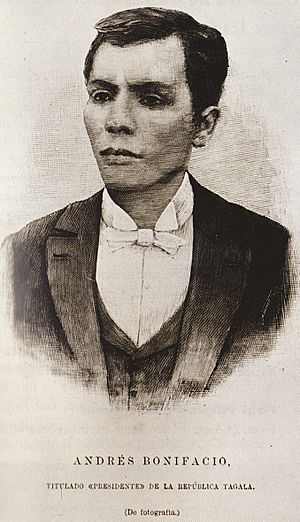Andres Bonifacio facts for kids
Quick facts for kids
Supremo
Andrés Bonifacio
|
|
|---|---|

An engraving of Bonifacio from 1897.
|
|
| Supreme Leader of the Sovereign Tagalog Nation | |
| In office August 24, 1896 – March 22 or May 10, 1897 |
|
| Vice President | Gregoria de Jesús |
| Preceded by | Office established Román Basa (as Leader of the Katipunan) |
| Succeeded by | Office abolished Emilio Aguinaldo (as President of Tejeros Revolutionary Government) |
| Personal details | |
| Born |
Andrés Bonifacio y de Castro
November 30, 1863 Tondo, Manila, Captaincy General of the Philippines |
| Died | May 10, 1897 (aged 33) Maragondon, Cavite, Captaincy General of the Philippines |
| Cause of death | Execution |
| Resting place | Unknown |
| Political party | La Liga Filipina Katipunan |
| Spouses | Monica (c. 1880–1890, her death) Gregoria de Jesús (1893–1897, his death) |
| Children | Andrés de Jesús Bonifacio Jr. (born in early 1896, died in infancy) |
| Education | Self-educated |
| Signature | |
| Nickname | Maypagasa |
| Military service | |
| Allegiance | |
| Years of service | 1895–1897 |
| Rank | Supremo |
| Battles/wars | Philippine Revolution
|
Andrés Bonifacio (born November 30, 1863 – died May 10, 1897) was a very important Filipino leader. He helped start the Philippine Revolution against Spanish rule. He is known as the "Father of the Philippine Revolution." Bonifacio was a brave revolutionary and a strong soldier. He wanted the Philippines to be free from Spain.
Contents
Andrés Bonifacio: A Filipino Hero
Andrés Bonifacio y de Castro was born in Tondo, Manila. This was in the Captaincy General of the Philippines. His family was not rich. He had to work hard from a young age.
Early Life and Education
Bonifacio did not go to a fancy school. He taught himself by reading many books. He learned about the French Revolution and other important historical events. He also read about the lives of presidents. This helped him understand how people could fight for freedom.
Founding the Katipunan
Bonifacio believed the Philippines should be free. He joined a group called La Liga Filipina. This group wanted changes from Spain. But Spain arrested its leader, José Rizal. After this, Bonifacio decided to form his own group.
The Secret Society
On July 7, 1892, Bonifacio founded the Kataas-taasan, Kagalang-galangang Katipunan ng mga Anak ng Bayan. This long name means "Highest and Most Honorable Society of the Children of the Nation." Most people just called it the Katipunan. It was a secret society. Its main goal was to gain independence from Spain.
- Members used secret codes and rituals.
- They recruited many Filipinos who wanted freedom.
- Bonifacio became the "Supremo," or Supreme Leader, of the Katipunan.
The Philippine Revolution Begins
The Katipunan grew very quickly. Spanish authorities soon found out about the group. This led to the start of the Philippine Revolution.
The Cry of Pugad Lawin
On August 23, 1896, Bonifacio and his followers gathered. They tore up their cedulas (community tax certificates). This was a sign that they were breaking away from Spain. This event is known as the Cry of Pugad Lawin. It marked the start of the armed uprising.
Battles and Leadership
Bonifacio led many battles against the Spanish. These included the Battle of Manila (1896) and the Battle of San Juan del Monte. He showed great courage and leadership. He was a key figure in the early days of the revolution.
Bonifacio's Legacy
Andrés Bonifacio is remembered as a national hero. He lit the spark for the Philippine Revolution. His bravery inspired many Filipinos to fight for their country's freedom. He is honored every year on his birthday, November 30.
Images for kids
See also
 In Spanish: Andrés Bonifacio para niños
In Spanish: Andrés Bonifacio para niños


